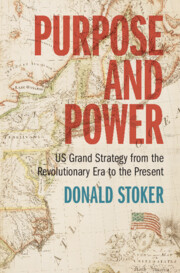Book contents
- Purpose and Power
- Purpose and Power
- Copyright page
- Dedication
- Contents
- Figures
- Maps
- Abbreviations
- Thinking about Grand Strategy in Peace and War
- Part I From Backwater to Great Power
- 1 The Fight for Sovereignty, 1775–1801
- 2 Expansion, Sovereignty, and War, 1801–1817
- 3 Seeking a Continent: Expansion, Indian Removal, and the Mexican War, 1817–1849
- 4 Schism, Civil War, and Reconstruction, 1849–1877
- 5 Conquering a Continent: The Indian wars, 1865–1897
- 6 American Empire, 1897–1913
- Part II From Great Power to Superpower
- Part III The Post–Cold War World
- Part IV Retreat and Defeat
- Acknowledgements
- Notes
- Index
3 - Seeking a Continent: Expansion, Indian Removal, and the Mexican War, 1817–1849
from Part I - From Backwater to Great Power
Published online by Cambridge University Press: 11 January 2024
- Purpose and Power
- Purpose and Power
- Copyright page
- Dedication
- Contents
- Figures
- Maps
- Abbreviations
- Thinking about Grand Strategy in Peace and War
- Part I From Backwater to Great Power
- 1 The Fight for Sovereignty, 1775–1801
- 2 Expansion, Sovereignty, and War, 1801–1817
- 3 Seeking a Continent: Expansion, Indian Removal, and the Mexican War, 1817–1849
- 4 Schism, Civil War, and Reconstruction, 1849–1877
- 5 Conquering a Continent: The Indian wars, 1865–1897
- 6 American Empire, 1897–1913
- Part II From Great Power to Superpower
- Part III The Post–Cold War World
- Part IV Retreat and Defeat
- Acknowledgements
- Notes
- Index
Summary
This chapter begins by examining the James Monroe and John Quincy Adams administrations. They continued America’s expansionist drive and the quest for security. John Quincy Adams was one of America’s first grand strategists, and he and Monroe used Andrew Jackson to secure parts of Florida from Spain while also giving us the Monroe Doctrine, which meant the US wouldn’t tolerate establishment of any European footholds in the Western hemisphere. They also fought the First Seminole War. Andrew Jackson succeeded Adams as president. Achieving security against enemies foreign and domestic was his key aim. He fought against the Bank of the United States, pursued Indian Removal that famously produced the “Trail of Tears,” quashed the Nullification Crisis, and fought wars against the Blackhawk, Creeks, and Seminole. The Martin Van Buren, William Henry Harrison, and John Tyler administrations are briefly examined on the way to the James K. Polk administration and the Mexican War. Polk’s victorious war, which included campaigns by Zachary Taylor and Winfield Scott, saw the US seize enormous tracts of Mexico, including California. Expansion was Polk’s aim. Expansionism became inextricably tied to Manifest Destiny in 1845.
Keywords
- Type
- Chapter
- Information
- Purpose and PowerUS Grand Strategy from the Revolutionary Era to the Present, pp. 77 - 117Publisher: Cambridge University PressPrint publication year: 2024

